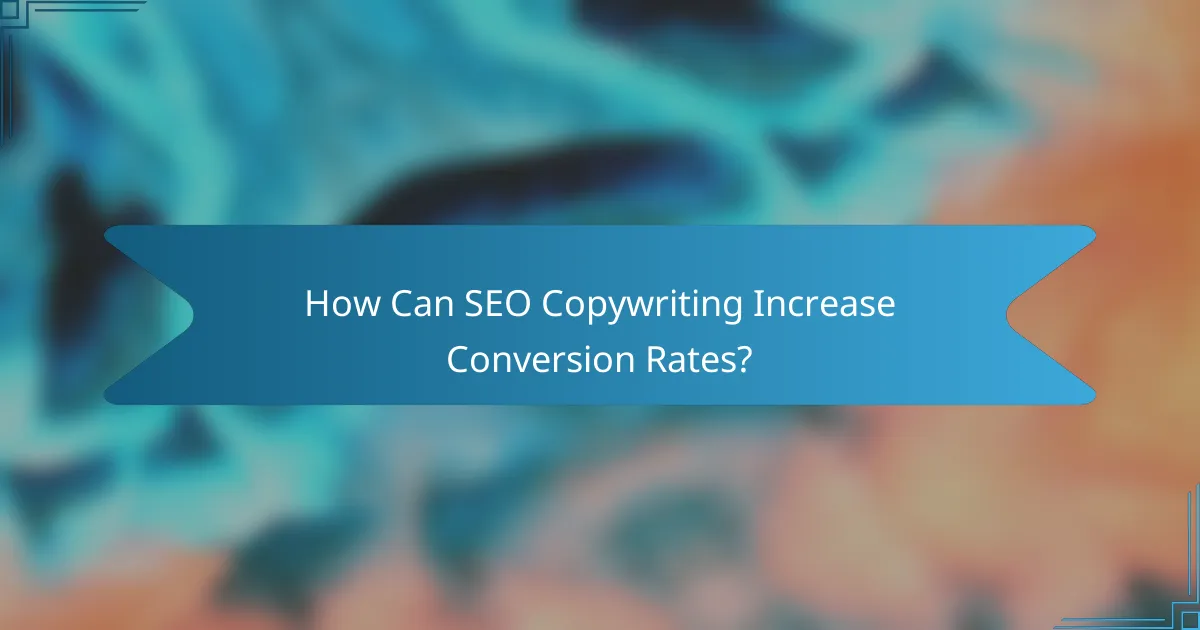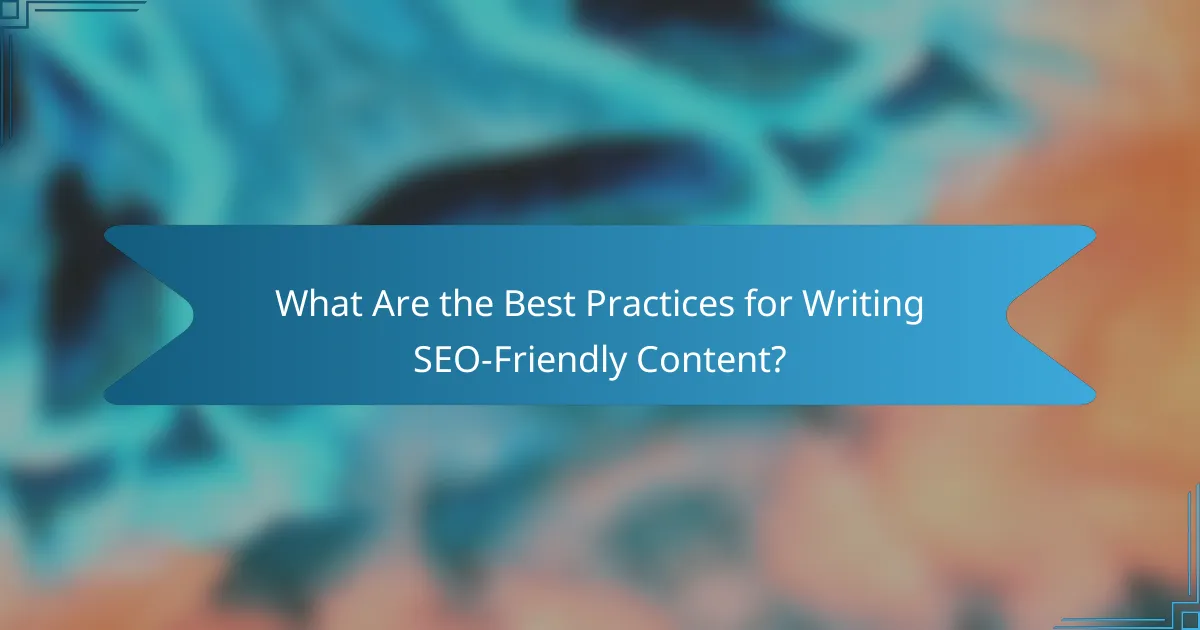SEO copywriting is a powerful tool for enhancing conversion rates by creating content that not only draws in visitors but also motivates them to take action. By employing persuasive language and targeting specific audiences, businesses can transform casual readers into loyal customers. Understanding audience needs and preferences is crucial for crafting tailored content that boosts engagement and drives conversions.

How Can SEO Copywriting Increase Conversion Rates?
SEO copywriting can significantly boost conversion rates by crafting content that not only attracts visitors but also persuades them to take action. By integrating persuasive language, targeting specific audiences, and optimizing content structure, businesses can effectively convert readers into customers.
Effective use of persuasive language
Persuasive language is crucial in SEO copywriting as it influences readers’ decisions. Using strong verbs, emotional triggers, and compelling adjectives can create a sense of urgency and importance. For example, instead of saying “buy now,” phrases like “secure your spot today” can enhance the appeal.
Additionally, employing techniques such as storytelling can engage readers on a deeper level, making the message more relatable and memorable. Highlighting benefits over features also helps in persuading the audience to act.
Targeted audience engagement
Understanding your target audience is essential for effective SEO copywriting. Tailoring content to meet the specific needs and preferences of your audience increases relevance and engagement. Conducting audience research can help identify pain points and desires, allowing you to address them directly in your writing.
Using language and examples that resonate with your audience’s demographics, interests, and behaviors can create a stronger connection. This targeted approach not only attracts the right visitors but also encourages them to convert.
Clear calls to action
Clear calls to action (CTAs) are vital in guiding readers toward the desired action. Each piece of content should include specific, action-oriented CTAs that tell the audience exactly what to do next. Phrases like “download your free guide” or “start your trial now” provide clarity and direction.
Positioning CTAs strategically within the content, such as at the end of a blog post or in a prominent sidebar, can enhance visibility. Testing different CTA styles and placements can help determine what works best for your audience.
Optimized content structure
An optimized content structure improves readability and keeps readers engaged, which can lead to higher conversion rates. Using headings, subheadings, bullet points, and short paragraphs makes it easier for readers to scan the content and find relevant information quickly.
Additionally, incorporating keywords naturally within the structure helps with SEO, ensuring that the content ranks well in search engines. A well-organized layout also enhances user experience, making it more likely that visitors will stay and convert.
Emotional appeal in messaging
Emotional appeal is a powerful tool in SEO copywriting that can drive conversions. By tapping into the emotions of your audience—such as fear, joy, or excitement—you can create a compelling narrative that resonates with them. This connection can motivate readers to take action.
Utilizing testimonials, success stories, or relatable scenarios can evoke emotions and build trust. Highlighting how your product or service can solve a problem or improve the reader’s life can further enhance this emotional connection, increasing the likelihood of conversion.

What Techniques Enhance Persuasive Language?
Persuasive language is enhanced through various techniques that engage the audience and drive conversions. Key methods include storytelling, social proof, and the use of power words, each contributing to a more compelling message.
Use of storytelling
Storytelling captivates audiences by creating relatable narratives that evoke emotions. A well-crafted story can illustrate a problem and present a solution, making the content more memorable and impactful.
To effectively use storytelling, identify a central character that your audience can connect with. This character should face challenges similar to those of your target audience, ultimately leading to a resolution that highlights your product or service.
Incorporation of social proof
Social proof leverages the influence of others to validate your message and encourage action. This can include testimonials, reviews, or case studies that demonstrate how others have benefited from your offering.
To incorporate social proof, gather authentic feedback from satisfied customers and display it prominently on your website. Aim for a mix of quantitative data, like satisfaction ratings, and qualitative insights that tell a compelling story of success.
Utilization of power words
Power words are emotionally charged terms that can trigger strong responses and motivate action. Words like “exclusive,” “guaranteed,” or “proven” can enhance the persuasive quality of your writing.
When utilizing power words, consider the context and audience. Use them strategically in headlines, calls to action, and key points to amplify your message. Avoid overusing them, as this can dilute their impact and come across as insincere.

How to Identify and Target Your Audience?
Identifying and targeting your audience involves understanding who they are and what they need. This process helps tailor your content to meet their preferences, ultimately improving engagement and conversion rates.
Demographic analysis
Demographic analysis focuses on quantifiable characteristics of your audience, such as age, gender, income, education, and location. By gathering this data, you can create content that resonates with specific groups. For example, targeting millennials may require a more casual tone and digital-first approach, while older audiences might prefer more formal communication.
Utilize tools like Google Analytics or social media insights to gather demographic data. This information can guide your content strategy, ensuring it aligns with the interests and needs of your target segments.
Behavioral segmentation
Behavioral segmentation categorizes your audience based on their actions, such as purchasing habits, website interactions, and engagement levels. Understanding these behaviors allows you to create tailored marketing messages that address specific pain points or interests.
For instance, if you notice a segment frequently abandons their shopping carts, you might target them with reminder emails or special offers. This targeted approach can significantly enhance conversion rates by addressing the reasons behind their behavior.
Utilizing audience personas
Audience personas are fictional representations of your ideal customers based on demographic and behavioral data. Creating detailed personas helps you visualize your audience, making it easier to tailor your content and marketing strategies effectively.
To develop effective personas, include information such as goals, challenges, and preferred communication channels. For example, a persona for a busy professional might prioritize quick, informative content delivered via email, while a student might engage more with social media posts. Regularly updating these personas ensures they remain relevant as market trends and audience behaviors evolve.

What Role Does Keyword Research Play in SEO Copywriting?
Keyword research is essential in SEO copywriting as it helps identify the terms and phrases that potential customers use when searching online. By understanding these keywords, writers can create content that aligns with user intent, ultimately improving visibility and conversion rates.
Identifying search intent
Understanding search intent is crucial for effective keyword research. It involves determining whether users are looking for information, making a purchase, or seeking a specific service. By aligning content with the identified intent, copywriters can create more relevant and engaging material that meets the needs of their audience.
To identify search intent, analyze the keywords users are entering and categorize them into informational, navigational, and transactional types. This will guide the tone and structure of your content, ensuring it resonates with the target audience.
Finding high-traffic keywords
High-traffic keywords are terms that attract a significant number of searches, making them valuable for SEO. Use tools like Google Keyword Planner or SEMrush to discover these keywords and assess their competition level. Aim for keywords that have a balance of high search volume and manageable competition.
When selecting high-traffic keywords, consider the relevance to your content and audience. A keyword with high traffic but low relevance may not convert well, so prioritize keywords that align with your offerings and user needs.
Long-tail keyword strategies
Long-tail keywords are longer, more specific phrases that typically have lower search volume but higher conversion potential. These keywords often reflect a user’s specific query, making them easier to rank for and more likely to attract targeted traffic.
Incorporate long-tail keywords into your content by addressing specific questions or problems that your audience may have. This can improve your chances of ranking higher in search results and attracting users who are further along in the buying process.
To effectively use long-tail keywords, create content that answers specific queries or provides detailed information on niche topics. This strategy not only enhances relevance but also positions you as an authority in your field.

What Are the Best Practices for Writing SEO-Friendly Content?
Writing SEO-friendly content involves creating material that is both engaging for readers and optimized for search engines. Key practices include using relevant keywords, maintaining appropriate content length, and effectively utilizing headings and subheadings.
Incorporating keywords naturally
Incorporating keywords naturally means using relevant terms throughout your content without forcing them in awkwardly. Aim to include primary keywords in the title, first paragraph, and a few times throughout the text, ensuring they fit seamlessly within the context.
Consider using synonyms and related phrases to enhance readability while still targeting the same search intent. Tools like Google Keyword Planner can help identify effective keywords and their variations.
Maintaining optimal content length
Optimal content length varies by topic but generally falls between 1,000 to 2,500 words for comprehensive coverage. Longer content tends to perform better in search rankings, as it often provides more value and detail.
However, prioritize quality over quantity. Ensure that every section adds value and remains relevant to the reader’s needs. Regularly review and update content to keep it fresh and aligned with current trends.
Using headings and subheadings effectively
Using headings and subheadings effectively helps organize content and improves readability. They allow readers to scan the material quickly, making it easier to find the information they need.
Incorporate keywords into your headings where appropriate, as search engines use these to understand the content structure. Aim for a clear hierarchy, using
for main sections and
for subsections, to guide readers through your article logically.

How Can A/B Testing Improve Copywriting Effectiveness?
A/B testing enhances copywriting effectiveness by allowing marketers to compare two versions of content to determine which performs better. This method provides data-driven insights that can significantly boost engagement and conversion rates.
Testing different headlines
Testing different headlines is crucial because the headline often determines whether a reader will engage with the content. By creating two or more variations of a headline, you can analyze which one attracts more clicks or conversions.
When conducting headline tests, consider factors such as length, emotional appeal, and clarity. For example, a headline that evokes curiosity may perform better than a straightforward one. Aim for headlines that are concise, ideally between 6 to 12 words, to capture attention quickly.
Common pitfalls include testing too many headlines at once or not giving each variation enough time to gather data. Focus on one element at a time, such as wording or structure, and allow the test to run for a sufficient duration to ensure reliable results. A good rule of thumb is to run tests for at least one to two weeks, depending on your traffic volume.
